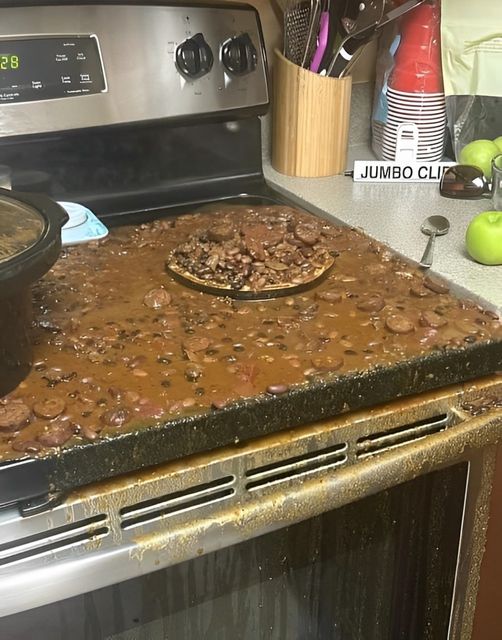Have you ever had a kitchen mishap so memorable that you still cringe just thinking about it? I know I have! Once, I placed a hot lid upside down on my brand-new glass stovetop, only to hear the dreaded cracking sound of the glass shattering beneath it. That expensive and frustrating mistake taught me an important lesson: even small errors in the kitchen can lead to big consequences. Since then, I’ve made a point to learn as much as I can about kitchen safety and avoid unnecessary disasters.

But no matter how careful we try to be, accidents happen. Recently, I came across a story in my favorite kitchen Facebook group that stopped me in my tracks. A member posted a photo of her stovetop covered in chili—so much that the stovetop itself was barely visible. She explained that after cooking chili in her crockpot on high for six hours, it wasn’t quite done. She decided to place the cooled crockpot insert on the stovetop to heat it further. But when she tried to move it to the fridge, disaster struck. The bottom gave way, and chili spilled everywhere. I could only imagine her frustration. If that were me, I’d probably be in tears before even attempting to clean up the mess.
This story got me thinking: why did this happen, and what could have been done differently? The comments in the group all echoed the same advice: never, ever place a crockpot on the stovetop. But why is this such a hard rule? Let’s break it down.
Is It Safe to Put a Crockpot on the Stove?
The short answer is no—it’s absolutely unsafe to put a crockpot on the stovetop. Crockpots are designed to be slow cookers, gently cooking food over a long period at low, steady temperatures. The ceramic insert in a crockpot is not built to handle the high, concentrated heat of a stovetop burner. Stovetop heat is direct and intense, which can cause the ceramic to crack or even shatter.
As we saw in the Facebook post, the result of placing a crockpot on the stovetop can be a catastrophic mess. When exposed to direct heat, the ceramic insert can’t withstand the stress, leading to what’s called a “bottom-out”—a complete failure of the crock’s structure. This not only ruins the meal but also leaves you with a stovetop to clean, potentially damaged cookware, and the risk of burns or cuts.
What Happens When You Put a Crockpot on the Stove?
When you place a crockpot on a stovetop burner, the most likely outcome is that the ceramic insert will crack, chip, or completely break. This can result in a major spill, with hot food and ceramic shards scattered everywhere. Beyond the immediate mess, there’s also the potential for injury. Hot chili or soup spilling out of a shattered crockpot could cause severe burns, and broken ceramic pieces can cut or scratch surfaces.
Even if the ceramic insert doesn’t shatter immediately, it may develop micro-cracks. These tiny, often invisible fractures weaken the structural integrity of the crockpot, making it more likely to fail in the future. What’s worse, using a compromised crockpot insert can also pose an electrical hazard if the heating element is damaged during the initial mishap.
Is Any Ceramic Safe for Stovetop Use?
You might be wondering if other types of ceramic cookware can safely be used on a stovetop. Generally, the answer is no. Most ceramic cookware is not designed for direct stovetop use unless it’s explicitly labeled as flameware or heat-resistant. These specialized ceramics are engineered to handle the intense heat of a stovetop burner, but they are the exception, not the rule. Always check the manufacturer’s guidelines before using any ceramic cookware on the stove to avoid damage or injury.
What’s the Solution?
So, how can you avoid a similar disaster? The key is to use the right tool for the job. A crockpot is made for slow, steady cooking on the countertop or in its base unit, not for the stovetop. If you need to transfer food to a stovetop for additional cooking, use a pot or pan specifically designed for that purpose. Stainless steel, cast iron, or other stovetop-safe materials are built to handle direct heat and won’t crack under the pressure.
By keeping your crockpot where it belongs—on the countertop—you’ll save yourself from potential messes, injuries, and costly repairs. Plus, you’ll ensure your meals turn out as delicious as you intended.
A Lesson in Kitchen Safety
After my own mishap with a glass stovetop, I became a bit of a kitchen safety enthusiast. I love trying new recipes and experimenting with different gadgets, but I’ve learned to approach everything with a little extra caution. Hearing stories like the one from the Facebook group reminds me that no matter how experienced we are in the kitchen, we’re all just one small mistake away from our next disaster.
So, let’s take these lessons to heart. Keep crockpots off the stovetop, use the right tools for the job, and prioritize safety in the kitchen. By doing so, you can focus on enjoying your cooking adventures—and avoid the stress of cleaning up an unnecessary mess.





